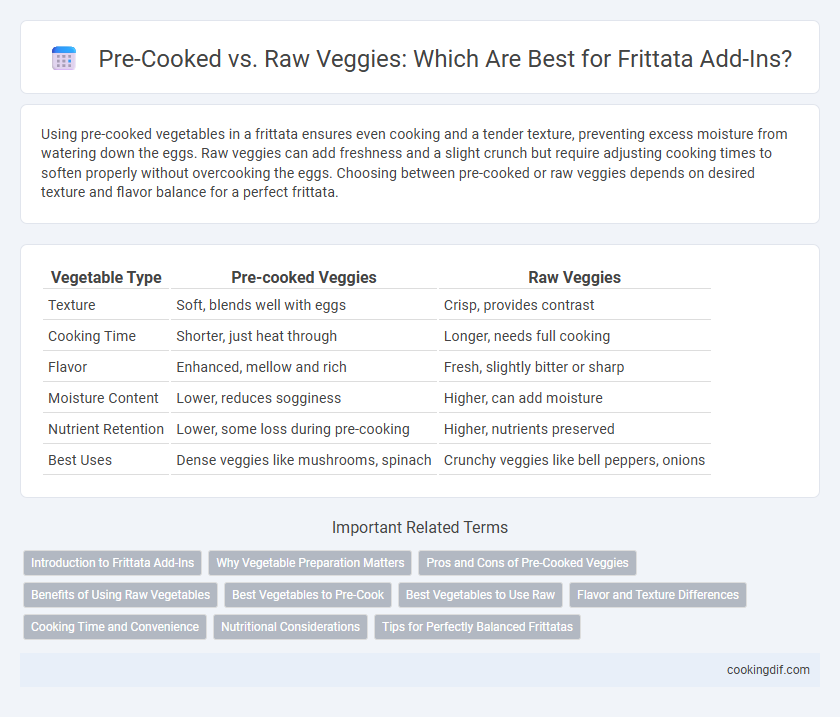Using pre-cooked vegetables in a frittata ensures even cooking and a tender texture, preventing excess moisture from watering down the eggs. Raw veggies can add freshness and a slight crunch but require adjusting cooking times to soften properly without overcooking the eggs. Choosing between pre-cooked or raw veggies depends on desired texture and flavor balance for a perfect frittata.
Table of Comparison
| Vegetable Type | Pre-cooked Veggies | Raw Veggies |
|---|---|---|
| Texture | Soft, blends well with eggs | Crisp, provides contrast |
| Cooking Time | Shorter, just heat through | Longer, needs full cooking |
| Flavor | Enhanced, mellow and rich | Fresh, slightly bitter or sharp |
| Moisture Content | Lower, reduces sogginess | Higher, can add moisture |
| Nutrient Retention | Lower, some loss during pre-cooking | Higher, nutrients preserved |
| Best Uses | Dense veggies like mushrooms, spinach | Crunchy veggies like bell peppers, onions |
Introduction to Frittata Add-Ins
Choosing between pre-cooked and raw veggies for frittata add-ins affects texture and cooking time significantly. Pre-cooked vegetables release less moisture, ensuring a firmer frittata, while raw veggies may introduce extra water, potentially making the dish softer or soggy. Selecting the right preparation method helps maintain the frittata's structural integrity and enhances flavor balance.
Why Vegetable Preparation Matters
Vegetable preparation significantly impacts the texture and flavor of a frittata, with pre-cooked veggies providing a softer, more integrated taste while raw veggies offer a fresher, crunchier bite. Using pre-cooked vegetables like sauteed spinach, caramelized onions, or roasted peppers prevents excess moisture from making the frittata watery and ensures even cooking throughout. Raw additions such as diced tomatoes or zucchini require careful balancing to avoid sogginess, making the choice of preparation essential for the ideal frittata consistency.
Pros and Cons of Pre-Cooked Veggies
Pre-cooked veggies in frittatas offer the advantage of enhanced flavor and texture, as they release moisture and soften during pre-cooking, preventing sogginess in the final dish. However, overcooking can lead to a loss of nutrients and a mushy consistency, diminishing the overall quality. Using pre-cooked vegetables saves time during assembly and ensures even cooking but requires careful attention to avoid excess moisture that can affect the frittata's structure.
Benefits of Using Raw Vegetables
Using raw vegetables in a frittata preserves their natural texture and vibrant flavors, enhancing the dish's freshness. Raw veggies also retain more nutrients such as vitamin C and antioxidants, boosting the meal's nutritional value. Their moisture content helps keep the frittata moist and tender without requiring extra cooking time.
Best Vegetables to Pre-Cook
Pre-cooking vegetables like onions, bell peppers, mushrooms, and spinach enhances their flavors and reduces moisture, preventing a soggy frittata. Harder vegetables such as zucchini, broccoli, and carrots benefit from sauteing or steaming to ensure tenderness and even cooking. Incorporating these pre-cooked vegetables maintains the frittata's texture while maximizing taste and nutritional value.
Best Vegetables to Use Raw
Bell peppers, spinach, and tomatoes are ideal raw vegetables for frittata add-ins due to their quick cooking time and ability to retain texture and flavor. Zucchini and mushrooms can also be used raw but may release excess moisture, so slicing thinly helps prevent a soggy frittata. Using raw vegetables ensures vibrant color and fresh taste while preserving essential nutrients often lost during pre-cooking.
Flavor and Texture Differences
Pre-cooked vegetables in a frittata release richer flavors and offer a softer texture, enhancing overall palatability by blending smoothly with eggs. Raw vegetables provide a crisp bite and fresher taste but may release excess moisture, potentially affecting the frittata's firmness and causing uneven cooking. Balancing pre-cooked and raw veggies can optimize flavor depth and texture contrast for a more satisfying dish.
Cooking Time and Convenience
Using pre-cooked vegetables in a frittata significantly reduces cooking time as they require only reheating, ensuring a quicker meal preparation. Raw vegetables add freshness and texture but need to be sauteed first, increasing both prep and cooking duration. Opting for pre-cooked veggies offers convenience without compromising flavor, ideal for busy schedules or quick breakfasts.
Nutritional Considerations
Using pre-cooked vegetables in a frittata can reduce water content and concentrate flavors, while retaining most nutrients like vitamins A and C, though some water-soluble vitamins may decrease. Raw vegetables preserve their nutritional integrity and fiber but can release excess moisture during cooking, potentially affecting texture. Balancing pre-cooked and raw veggies optimizes nutrient retention and enhances the frittata's overall taste and mouthfeel.
Tips for Perfectly Balanced Frittatas
Using pre-cooked vegetables in frittatas ensures a tender texture and prevents excess moisture that can make the dish soggy, while raw vegetables add freshness and crunch but may require additional cooking time to soften. To achieve a perfectly balanced frittata, saute raw veggies like onions, bell peppers, or spinach briefly before adding them, allowing their flavors to meld and excess water to evaporate. Combining pre-cooked and raw vegetables strategically enhances flavor depth and textural contrast, resulting in a well-balanced and flavorful frittata.
Pre-cooked vs Raw veggies for Frittata add-ins Infographic

 cookingdif.com
cookingdif.com